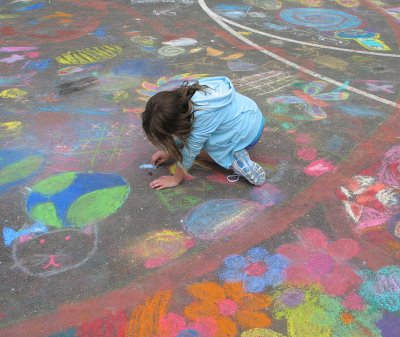Help! My child hates anything to do with drawing!
Oct 17, 2014
It can be challenging when a child doesn't want to draw... especially when you are preparing for a cracking pace Prep curriculum in the current Australian school system. We know that early drawing and pre-writing skills are laying the foundations for pencil control and writing. But what can we do when our child hates drawing?
First of all take a deep breath... and make a decision that you will take the pressure off yourself and your child. In the same way you wouldn't force a child to walk when they were just learning to roll over, there is no need to pressure a child to draw. You want to gently lead them with fun, shared joy, and enjoy each stage as they progress.
Here are some activities to enjoy together through this time:
1. Collect sheets of cardboard from appliance shops and make easels. Drawing on a vertical surface puts the hand in a position where the wrist is extended (bent back) and the arches in the palm are supported. The fingers are then in a better position to be able to control a tool like chalk, crayons, markers or even a paint brush. Remember the grasp pattern for painting is really different to drawing so try not to limit vertical drawing only to painting opportunities.
2. Taking it one step further... I love to find a little, low table and tape some paper on the underside of it. Then I take turns with a child drawing pictures or writing on the paper. It can become a fun game. Boys who hate drawing often love this activity, and pretend they are underneath a car fixing it. You can draw things for each other to copy, or draw shapes or pictures to colour in. Or do some rainbow writing under there.
3. Rainbow writing is one of my favourite activities with a child. You simply trace over a shape or letter in lots of different colours. It's a fun way to work on letter formation, but is great as an early drawing activity because at the end the child has a really cool picture that you have worked on together.
4. Water colour crayons and spray bottles. One of my children was allergic to drawing until he was about 5 years old! He hated it and avoided it at all costs. This was one of the activities that inspired him. He loved doing rainbow writing with cool water colour crayons, then spraying it, and watching it melt. But he also just loved drawing really big pictures of aliens and then shooting them and watching them melt (a great activity on those big sheets of cardboard you kept). The spray bottles are also helping develop grip strength and preparing a child for learning to use scissors.
5. Driving cars on roads in the sandpit... drawing doesn't have to look like drawing. Sometimes it can look like driving cars around in the sandpit. If you don't mind a bit of mess you can lay out one of your big sheets of cardboard, and dip old toy cars into paint and drive them around.
6. Drawing with sticks in the dirt and sand is also a fun way to encourage drawing. There is lots of feedback and resistance when drawing this way. Large sticks use a paint brush style grip, and smaller rocks will use a more refined grasp. And wet sand feels different to dry sand or dust - so vary it.
The main thing is that you have fun together. This is about sparking an interest, not pressuring a child to hold their crayon in a certain way or draw particular pictures or shapes.
I would really love to hear your experiences about your child. Have they avoided drawing and writing? What fun activities have you tried to encourage them to draw? What led to breakthrough for your child? You never know, your child's experience may be just the key another parent is needing to help their child develop a fresh attitude about drawing.
Want to read more about what do do about a child's pencil grip?
Would a bOble help my child have fun while they draw?
Disclaimer
The information, including but not limited to text, graphics, images, and other material contained on this website are for informational purposes only. This website is not intended to be a substitute for professional medical, healthcare or educational advice, diagnosis, or treatment. Always seek the advice of a qualified healthcare provider for any questions you may have regarding you or your child’s health concerns, and never disregard professional medical advice or delay in seeking it because of something you have read on this website.
blog comments powered by Disqus

